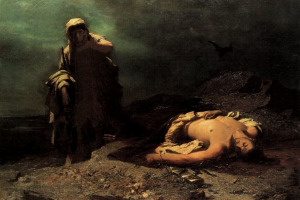Climax of Antigone: The Beginning of an Finale
 The Climax of Antigone sneaks up on the viewers, the rising action of the play is subtle enough to pass, and before you know it, the climax has appeared. The Sophoclean tragedy is written with a certain precision that smoothly transitions from one scene to another. But to pinpoint and grasp the climax, one must be familiar with the play itself and on that note, let us go over the events of the tragedy.
The Climax of Antigone sneaks up on the viewers, the rising action of the play is subtle enough to pass, and before you know it, the climax has appeared. The Sophoclean tragedy is written with a certain precision that smoothly transitions from one scene to another. But to pinpoint and grasp the climax, one must be familiar with the play itself and on that note, let us go over the events of the tragedy.
Antigone
Antigone, the sequel to Oedipus Rex, starts as Antigone returns to Thebes after her father’s death; she is informed of the injustice her brother faces. The new king, Creon, has dubbed Polyneices and refuses to bury him as punishment, leaving his body to rot on land.
The play begins as Ismene and Antigone bury over the newly passed law that prevents their brother from being buried. Antigone is exasperated and frustrated over the events and urges her sister to radically change her beliefs and join her in her tryst against Creon. Antigone plans to bury their brother despite the imminent threat of death and wants Ismene, Antigone’s sister, to do the same. Ismene is reluctant and tries to rationalize with Antigone, fearing the execution they’d face with such acts. Antigone, angry at her refusal, decides to bury their brother without Ismene, prompting the latter to rethink her thoughts.
Antigone strides towards the palace grounds and immediately finds her brother’s body. She digs a grave beside him and successfully buries Polyneices’ body in the process. She is caught by two palace guards and is immediately brought to Creon. Ismene rushes to her sister’s side as she hears the news of her capture and witnesses Creon’s decree. She begs to join her sister in her punishment, to which Antigone strongly contends. In the end, Antigone is subjected to being entombed in a cave. A big slap to the face of those who believe in the Divine beings.
As our heroine is imprisoned in the tomb, she thinks of the events that have left her on the path she walks on today. This could be seen as Antigone’s turning point as she decides to surrender to her family’s curse, the fate she’s tried so hard to fight. She takes her own life as she refuses to heed Creon’s decree. Creon had imprisoned her, a woman of royal blood, instead of executing her as he announced. He planned to imprison her for a long time, only giving her necessary food for survival in hopes of her death in the tomb. And in that way, he has no blood on his hands and cannot be held responsible for a royal’s death.
Haemon, Antigone’s lover, attempts to convince his father, Creon, to let his beloved go but is refused in the process. He hatches a plan to free her and runs towards the tomb. At the exact moment, Tiresias, the blind prophet, warns Creon about his hubris, encouraging him to release Antigone for his actions were against the gods. Creon realizes the implication of his actions and quickly rushes to free Antigone.
As Creon arrives in the tomb, he finds the bodies of his son Haemon and Antigone cold and dead. He regrets his actions as he brings his son to the castle. Eurydice, Creon’s wife, finds out about her remaining son’s suicide and curses Creon in the palace. Already on the brink of insanity, the queen further breaks as her remaining son passes due to her husband’s mistakes. She takes her life, longing to be with her beloved sons, hoping to cause Creon the same pain she had felt.
As Creon realizes that he is the only remaining one in his family, he laments his hubris and decision. He lives the rest of his life in misery as his actions bring him to loneliness.
What Is the Climax of Antigone?
 Antigone’s rising action is said to occur as Creon imprisons his son’s lover to a tomb for breaking his laws. During her imprisonment, Tiresias warns Creon of his transgressions against the people and the gods. He urges the king to set his hubris aside and rightfully bury Polyneices’ body as per the gods’ commands. Tiresias recounts his vision to the Theban king, cautioning him with his actions, warning him of the repercussions it could cause. Creon condemns Tiresias’ prophecy until Choragos helps him realize his faults, but his change of heart bears no fruit as he struggles to accept the death of his only remaining son.
Antigone’s rising action is said to occur as Creon imprisons his son’s lover to a tomb for breaking his laws. During her imprisonment, Tiresias warns Creon of his transgressions against the people and the gods. He urges the king to set his hubris aside and rightfully bury Polyneices’ body as per the gods’ commands. Tiresias recounts his vision to the Theban king, cautioning him with his actions, warning him of the repercussions it could cause. Creon condemns Tiresias’ prophecy until Choragos helps him realize his faults, but his change of heart bears no fruit as he struggles to accept the death of his only remaining son.
There is various Antigone analysis regarding the Sophoclean play’s climax. Climax refers to the significant highest point of tension or the most exciting part of the play leading towards the end. And it’s climax is heavily debated due to the play’s intense and straightforward plot structure of Antigone. Some regard the Climax as Creon’s turning point. The scene of him rushing towards the tomb to free Antigone is undoubtedly one of the most intense scenes in the play, but what occurs after is tragic as he sees his remaining son’s corpse. The tragedy is heightened as the play’s climax could have been prevented if the characters had headed Tiresias’ warnings.
Conflict in Antigone
The central conflict in Antigone sets up the Antigone plot climax. Antigone is a pious woman who devotedly believes in the all-mighty power and wisdom of the Greek gods and goddesses. The gods and goddesses had bestowed a decree that all living beings in death and only in death must be buried to pass onto the underworld.
So when Antigone hears of Creon’s law, she is infuriated as the new Theban king dares place himself on equal footing with the gods. Antigone views Creon’s decree as blasphemous and refuses to heed his commands; her humble persona is nowhere to be seen as she prioritizes the laws of those above them. Because of that, the central conflict in Antigone is the ever-present and controversial topic of “Church vs. State.”
Resolution in Antigone
The resolution in Antigone is seen as Creon carries his remaining son’s body into the palace. This scene emphasizes his realization of the repercussions of his actions. He understands that he’d caused the tragedy that had befallen him as he refused to heed any advice given to him. A messenger then informs him of his wife’s death, cursing him as she took her last breath, and Creon is left paralyzed in sorrow. He had placed himself on equal footing with the gods and had lost his son and wife in the process. The chorus then closes the play by imparting an important lesson: The gods punish the proud for it brings wisdom.
Antigone Analysis
Antigone, the first female protagonist in the ancient world of drama, has been interpreted as heroic and stubborn because she causes the death of two other people as she prioritizes her loyalty to the dead instead of the living. The play, one of Sophocles’ most influential pieces, has garnered both respect and criticism throughout its time.
The classic example of a Greek tragedy begs to be analyzed as its events culminate in the combination of divinity, morality, and justice. Their family’s curse stems from her grandfather, King Laius, who raped and kidnapped Chrysippus, cursing his family into tragedy. The curse continues down to Antigone, who ends their tragic fate, leaving her sister, Ismene, the sole survivor of their family.
Some analyze the play to be Creon’s tragedy and not Antigone’s, for the king had lost far more than our heroines and is centered solely on his mistakes. The drama would not have occurred if it was not for his abuse of power and blatant disregard for familial, divine, and personal responsibilities.
The tragedy of Antigone and her death may be seen and interpreted as a result of fate, justice, and retribution that results from her family’s sins: Laius’ crime of rape, the birth of Antigone and her siblings from an incestuous affair, and the patriarchal murder that occurred in the previous play.
Conclusion:
Now that we’ve talked about the climax, what it is, and pinpointing where it begins and ends in the Sophoclean tragedy, let us go over some key points to this article:
 Climax Is the peak of events from which the audience gains the most tension from
Climax Is the peak of events from which the audience gains the most tension from- Antigone, the sequel to Oedipus Rex, starts as Antigone returns to Thebes after her father’s death; she is informed of the injustice her brother faces.
- The central conflict in the plot is the never-ending, infamous, and controversial topic of the church vs. state.
- In this case, Athena represents the church, and Creon represents the state, creating a power dynamic that harms those around them and takes their lives away.
- Antigone unknowingly causes two more deaths with her apparent suicide. Although her loyalty to her can be commendable, she lacked to see what is really in front of her, Ismene.
- Antigone abandons Ismene as she joins the rest of her family in the afterlife, wishing the young girl a happy life.
- The rising action in Antigone is her punishment. She is dragged towards the tombs where she will carry out the rest of her life, imprisoned for her transgressions. This way, Creon would have little to no blood on his hands, waiting for Antigone to weaken and eventually pass.
- The climax occurs as Creon rushes towards the tomb to set the heroine free but is weakened as he sees his son’s corpse. Creon’s turning point turns out to be his realization as he witnesses the divine gods’ anger.
- Creon lives in misery as he realizes what he’s done to his wife and sons. His first son died in the war for Thebes, and the second one took his life because of the Theban king’s mistakes.
- The play is resolved as the chorus impart their knowledge upon the viewers; The gods punish the proud, but with it comes wisdom.
In conclusion, the climax of Antigone is set up by the central conflict within the tragedy, “church vs. state.” The conflict between the two opposing areas does not stem from contrasting ideas but stems from both sides’ confrontation. Sophocles emphasizes the importance of humility as the climax portrays the consequences of hubris while the ending illustrates the need for punishment; punishment brings about wisdom as one ponders on his actions’.

